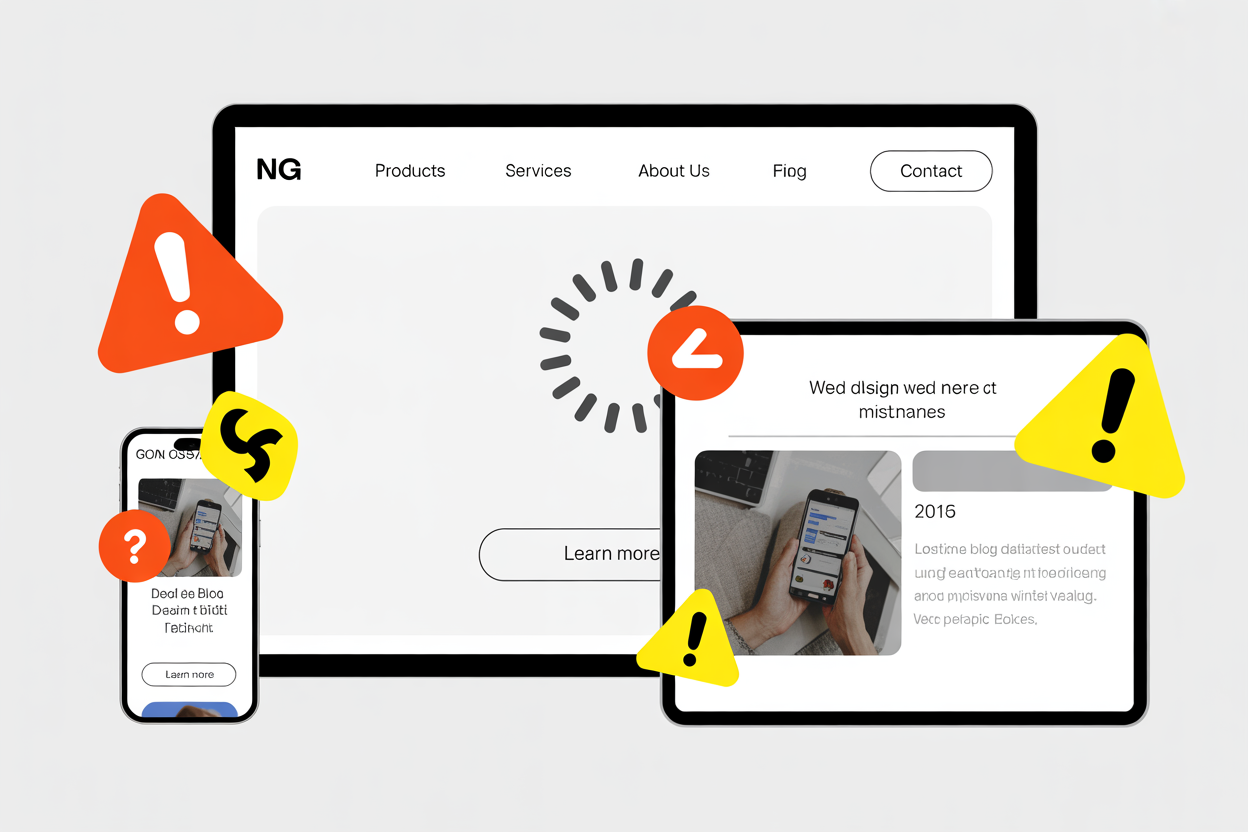1. Neglecting Mobile Responsiveness
In today’s fast-paced digital age, mobile devices are king. Think about your own browsing habits—how often do you reach for your phone to Google something, read a blog, or shop online? Probably all the time, right? That’s why neglecting mobile responsiveness is one of the deadliest mistakes you can make when it comes to your website.
A site that isn’t optimized for mobile is essentially telling visitors, “Go somewhere else.” And guess what? They will. Over 60% of web traffic comes from mobile devices, and if your site doesn’t look good or work right on a smartphone or tablet, you’re losing that audience. Not to mention, Google uses mobile-first indexing, which means your mobile site—not the desktop version—determines your rankings. So if it stinks, your SEO will suffer too.
You may think your site looks okay on mobile because it loads, but there’s a big difference between loading and actually being responsive. Text that’s too small, images that don’t scale, or buttons that are hard to tap—all these flaws add up to a bad experience. And no one wants to pinch and zoom just to read your “About Us” page.
Here’s what to do:
Start by checking your site with Google’s Mobile-Friendly Test. It’ll tell you right away if your site is responsive. Then, adopt a mobile-first design approach. That means designing for smaller screens first, then scaling up. Use responsive frameworks like Bootstrap, and make sure your content is legible, your menus are tappable, and your site feels natural on a phone.
Bottom line? If your site isn’t mobile-friendly, you’re missing out on a massive audience—and giving them every reason to click away.
2. Slow Website Loading Speeds
If your website loads like it’s stuck in dial-up days, you’re in trouble. People expect pages to load instantly. In fact, studies show that 40% of users will abandon a site that takes more than 3 seconds to load. That’s almost half your potential customers—gone before they even see your content.
But it’s not just about the bounce rate. Site speed is a confirmed Google ranking factor. A slow-loading website doesn’t just frustrate users—it also tells search engines that your site offers a poor user experience. That means lower rankings, less traffic, and ultimately, fewer conversions.
So what’s slowing your site down? Could be a number of things:
- Massive image files that aren’t compressed
- Bloated plugins or scripts
- Poor web hosting
- No browser caching
- Too many redirects
- Unoptimized code (especially JavaScript and CSS)
The worst part? Many site owners don’t even realize their site is slow because they test it on high-speed connections or local devices. But your audience isn’t always on fiber-optic Wi-Fi—they could be using mobile data in a low-signal area. If your site crawls under those conditions, you’ve lost them.
Fortunately, fixing speed isn’t rocket science. Start by testing your site with tools like Google PageSpeed Insights or GTmetrix. These will give you detailed reports and actionable suggestions. You can compress images with tools like TinyPNG, remove unnecessary plugins, enable caching, and switch to a high-performance hosting provider.
Improving your site speed doesn’t just make Google happy—it makes your users happy too. And happy users are far more likely to convert.
3. Poor Navigation and User Experience
Let’s play a quick game: Pretend you’re a new visitor to your own site. Now try to find your contact form or your latest blog post. Could you find it easily? If not, your navigation is failing you—and your users.
A confusing or cluttered navigation system is a silent killer of engagement. It overwhelms your visitors, increases bounce rates, and makes it nearly impossible for them to find what they need. And in the digital world, if users can’t find it fast, they don’t stick around.
Common signs your navigation is failing:
- Too many menu items (more than 5–7 is overwhelming)
- Hidden navigation or hamburger menus on desktop
- No logical page hierarchy or content structure
- Lack of a search bar
- Missing breadcrumbs or poor internal linking
A good user experience (UX) guides people through your site like a GPS. Everything should feel intuitive, from where to click next to how to return to the home page. When navigation is smooth, visitors stay longer, read more, and convert better. When it’s clunky or confusing, they bounce.
Want to fix it? Use a clean, simple menu structure. Group related items together and use dropdowns wisely. Make sure every important page is just one or two clicks away. Add a clear call-to-action in your header. Use internal linking to keep users flowing naturally from one page to another.
Also, don’t ignore your footer—it’s valuable real estate for secondary links, contact info, and legal pages. And if your site has a lot of content, a search bar is a must.
UX is everything. If your website is hard to use, people won’t use it. It’s that simple.
4. Lack of Clear Call-to-Actions (CTAs)
Ever walked into a store and had no idea where to go or what to do? That’s exactly how your website visitors feel if you don’t give them clear, compelling calls-to-action. A CTA isn’t just a button—it’s your digital salesperson. Without it, you’re leaving money on the table.
Whether it’s “Buy Now”, “Get a Free Quote”, or “Join Our Newsletter”, every page on your site should guide users to take a specific action. That’s how you convert traffic into leads, and leads into customers. But so many websites miss this opportunity by either hiding their CTAs or making them so generic no one feels inspired to click.
Common CTA mistakes include:
- Vague text like “Submit” or “Click Here”
- CTAs that are buried at the bottom of a long page
- Too many CTAs on one page (confusing!)
- CTAs that don’t stand out visually
So what makes a CTA effective? It’s all about clarity and motivation. Tell users exactly what they’ll get and why it benefits them. Use action-oriented language—think “Start My Free Trial” or “Download the Guide.” Make it urgent. Make it enticing. Make it impossible to ignore.
Also, design matters. Your CTA buttons should pop off the page using contrasting colors. They should be large enough to tap on mobile and located above the fold whenever possible. Don’t make users scroll to take action.
A/B test different versions. Sometimes a single word change can double your conversion rate. The key is to think like a visitor: What do I want to do here? Then build your CTA around that answer.
You don’t want passive visitors—you want action-takers. A great CTA is the nudge that turns a browser into a buyer.
5. Outdated or Low-Quality Content
Content is the heartbeat of your website. It informs, educates, builds trust—and ultimately drives conversions. But if your content is outdated, poorly written, or just plain thin, your site will struggle to compete. Visitors can tell the difference between valuable insight and content that was slapped together in five minutes.
Outdated content sends a message that your business isn’t active or credible. Imagine landing on a blog post from 2017 about SEO “tricks” that don’t even work anymore. It’s not just useless—it’s damaging. Google also penalizes stale content, especially if it’s inaccurate or irrelevant.
Then there’s the issue of thin content—pages with little to no value. Think 100-word blog posts, duplicate content, or filler copy that’s stuffed with keywords. That kind of content doesn’t just annoy users—it also tanks your SEO.
Here’s what to do:
- Audit your content regularly. Remove or update anything that’s no longer relevant.
- Focus on depth and originality. Long-form, well-researched posts perform better in both rankings and engagement.
- Break up text with visuals, bullet points, and subheadings to improve readability.
- Use tools like Surfer SEO or Clearscope to optimize your content for keywords without overstuffing.
Also, remember that content isn’t just blog posts. Your homepage, service pages, FAQs—all of it needs to be current, engaging, and aligned with your brand voice.
High-quality content builds authority. It keeps users on your site, earns backlinks, and boosts your SEO from every angle. Don’t treat it like an afterthought.
Conclusion: Turn Mistakes into Wins
Every website—no matter how big or small—has room for improvement. The truth is, even seasoned developers and marketers occasionally overlook the basics. But the good news? Every mistake we’ve talked about here is 100% fixable. And once you address these five critical areas—mobile responsiveness, loading speed, user experience, clear CTAs, and quality content—you’re well on your way to building a website that works for your visitors and your business.
Think of your website as your digital storefront. Would you leave your shop messy, outdated, and hard to navigate? Of course not. Your online presence deserves that same level of attention and polish. It’s not just about looking good—it’s about performing well, converting visitors, and making your brand shine.
Here’s a final tip: Don’t try to tackle everything in one day. Start with the biggest pain points—maybe your site is slow or the CTAs are weak—and build from there. Use tools, get feedback, and always put yourself in the shoes of your visitors. Ask, “Is this helpful? Is this easy? Is this fast?”
Because when your website feels effortless to use, everything else gets easier: better rankings, more traffic, higher conversions, and a reputation that actually reflects how awesome your brand is.
Ready to Fix Your Website and Grow Your Business?
Your website shouldn’t be holding you back. At Sveneria, we help businesses like yours avoid costly website mistakes with expert solutions tailored to your goals. Whether it’s responsive website development, landing page creation, SEO optimization, or deep-dive analytics and reporting, we make sure every pixel and click works for your success.
Don’t let slow load times, bad UX, or weak CTAs cost you leads. Let our team revamp your site for higher traffic, better engagement, and real conversions.
Let’s optimize your website. Get your free audit now!





